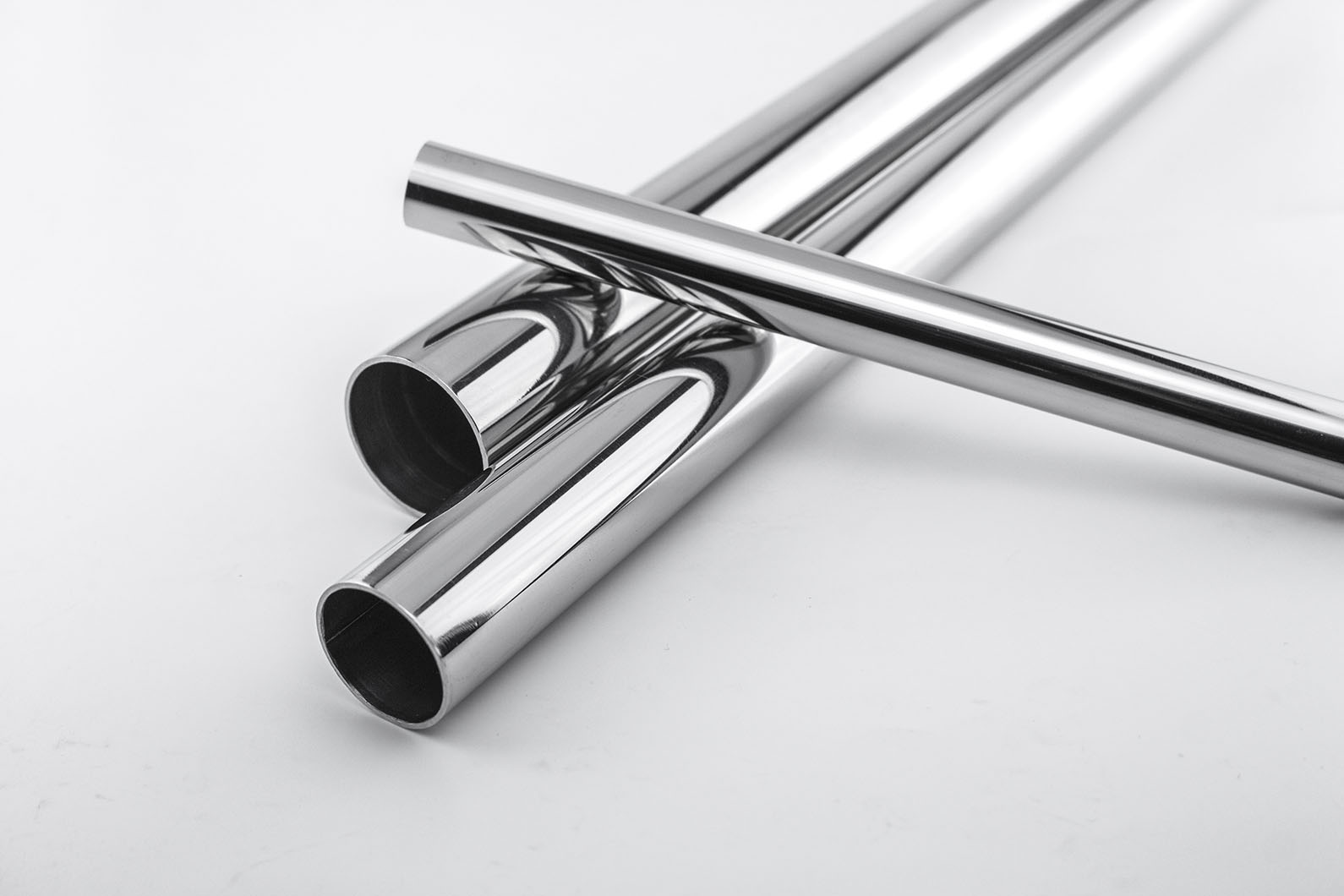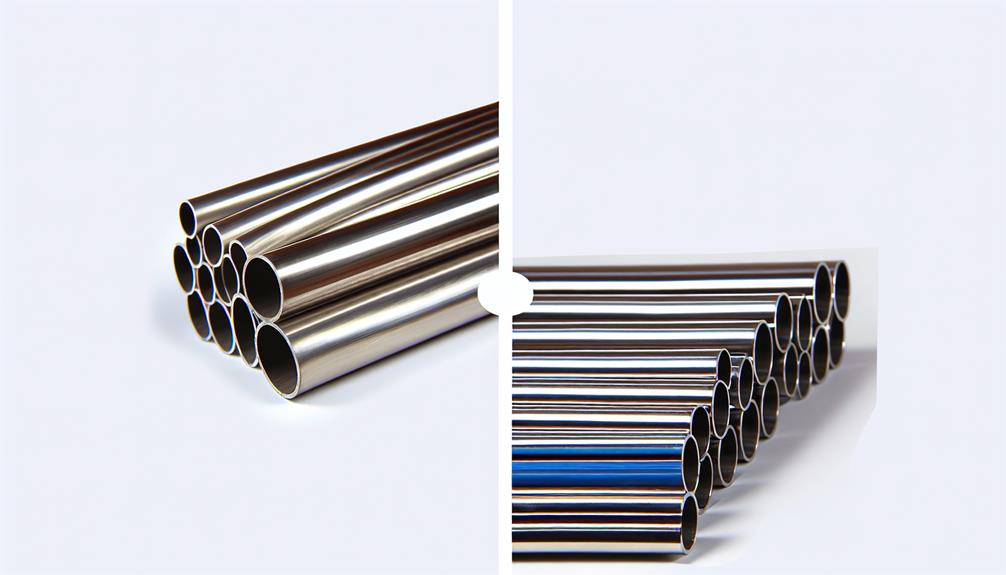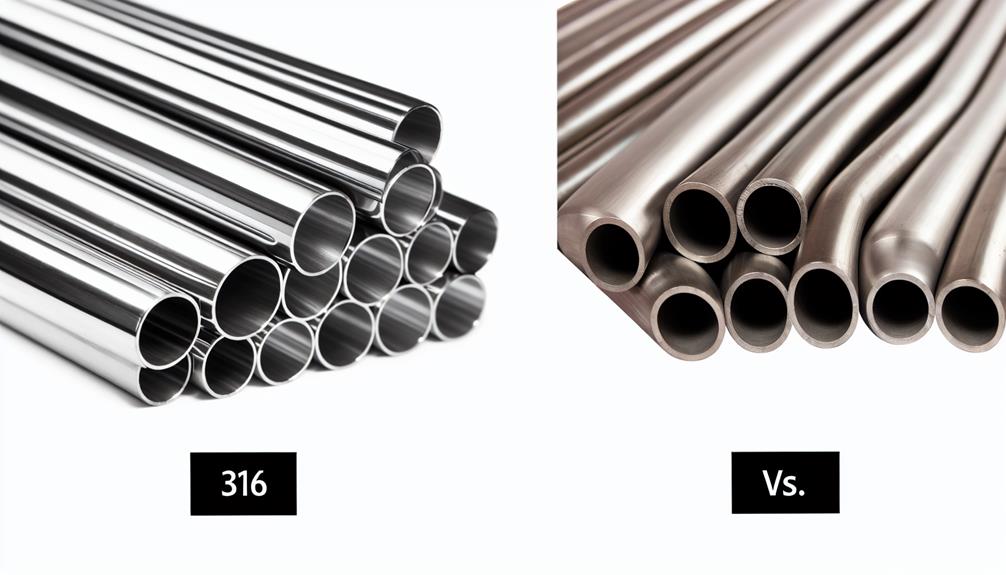When comparing 304 vs. 316 stainless steel sanitary tubing, consider their corrosion resistance. 304 is common across industries, while 316 excels in acidic environments. The choice hinges on specific sanitary needs, with 316 ideal for pharmaceutical and marine sectors. Differences lie in their chemical compositions, with 316 offering superior strength due to molybdenum. 304 suits food, beverage, and medical uses, whereas 316 shines in critical applications. Explore further to grasp the nuances impacting your selection.

Stainless steel is universally recognized for its exceptional sanitary properties, making it the preferred material for a wide range of applications, including sanitary valves, strainers, and clamps.
The inherent cleanliness of stainless steel is attributed to its corrosion-resistant nature, crucial for maintaining hygiene standards in industries like food and beverage, pharmaceuticals, and medical settings.
Specifically, when it comes to sanitary tubing, stainless steel offers a non-porous surface that prevents the accumulation of contaminants, ensuring the purity of the transported substances. This feature is particularly vital in industries where the prevention of bacterial growth and cross-contamination is paramount.
The smooth, crevice-free structure of sanitary stainless steel tubing eliminates the risk of harboring harmful particles, making it easy to clean and sterilize. Additionally, stainless steel's durability and longevity contribute to its sanitary appeal, providing a long-lasting solution for critical applications where cleanliness is non-negotiable.
Explore the different types of sanitary pipes for insights into their applications and advantages.
Stainless steel is a versatile material prized for its exceptional corrosion resistance, durability, and hygienic properties, making it an ideal choice for sanitary tubing applications. The American Iron and Steel Institute (AISI) and the American Society for Testing and Materials (ASTM) have established standardized grading systems to classify stainless steel alloys based on their chemical composition and properties.
304 Stainless Steel:
304L Stainless Steel:
316 Stainless Steel:
316L Stainless Steel:
These grades of stainless steel tubing offer a combination of corrosion resistance, mechanical strength, and fabricability tailored to meet the stringent requirements of sanitary applications. By understanding the characteristics and differences between these grades, engineers and designers can make informed decisions to ensure optimal performance and reliability in their systems.

304 stainless steel sanitary tubing stands out as a highly coveted material in industries prioritizing hygiene and corrosion resistance. Crafted primarily from iron, chromium, and nickel, supplemented with trace elements, this alloy boasts a distinctive amalgamation of properties that render it indispensable for sanitary applications.
The meticulously balanced composition of 304 stainless steel tubing bequeaths exceptional corrosion resistance, facile fabrication, and hygienic properties, rendering it an exemplary choice across sectors such as food and beverage processing, pharmaceuticals, and biotechnology.
In essence, 304 stainless steel sanitary tubing emerges as the preferred choice in industries mandating pristine hygiene, unwavering durability, and corrosion resistance. Its amalgam of qualities renders it indispensable across a spectrum of applications, from food processing to pharmaceutical manufacturing and beyond.
| Pros | Cons |
|---|---|
| Excellent corrosion resistance | Susceptible to corrosion in highly acidic or chloride-rich environments |
| Easy to clean and maintain | May require passivation after welding |
| Versatile and suitable for various applications | Limited high-temperature capabilities |
| Good formability and weldability | Not as strong as some other stainless steel alloys |
| Hygienic properties due to smooth surface finish | Higher initial cost compared to some other materials |
| Aesthetic appeal with lustrous finish |
Discover more about 304 Stainless Steel:

In industries where cleanliness, hygiene, and corrosion resistance are non-negotiable, 316 stainless steel sanitary tubing emerges as the gold standard. Crafted from grade 316 stainless steel, this tubing represents a pinnacle of quality and performance in austenitic stainless steel alloys. Let's delve into the defining features of 316 stainless steel sanitary tubing and understand why it's the preferred choice for critical sanitary applications.
The composition of 316 stainless steel is a harmonious blend of essential elements that define its exceptional properties:
316 stainless steel sanitary tubing embodies a fusion of exceptional properties and impeccable composition. Its unparalleled corrosion resistance, hygienic properties, and robustness make it the cornerstone of sanitary applications demanding uncompromised performance. With 316 stainless steel, reliability isn't just a promise – it's an inherent attribute, ensuring peace of mind in the most critical environments.
| Pros | Cons |
|---|---|
| Superior Corrosion Resistance | Higher Initial Cost |
| Excellent Resistance to Acids and Chlorides | Potential Sensitization During Welding |
| Enhanced Heat Resistance | Slightly Lower Strength than 304 |
| Smooth Surface Finish for Hygienic Applications | Greater Difficulty in Fabrication |
| Longevity and Durability |
Explore more about 316 vs. 316L Welded Stainless Steel Pipe

The difference between 304 and 316 stainless steel sanitary tubing lies primarily in their chemical compositions, resulting in distinct properties and applications.
While 304 stainless steel is cost-effective and widely used, 316 stainless steel offers superior corrosion resistance, making it ideal for more demanding environments.
Understanding these disparities is crucial in selecting the appropriate stainless steel grade for specific sanitary tubing requirements.
The chemical composition disparity between 304 and 316 stainless steel sanitary tubing is marked by variations in key alloy elements such as chromium, nickel, and molybdenum.
Chromium Content:
Nickel Content:
Molybdenum Content:
These differences play a significant role in defining the properties of each stainless steel grade. Chromium enhances corrosion resistance and strength, nickel improves corrosion resistance and toughness, while molybdenum primarily enhances corrosion resistance. Understanding these variations is crucial in selecting the most suitable grade for specific applications.
The distinction between 304 and 316 stainless steel sanitary tubing lies prominently in their mechanical properties, with 316 exhibiting superior strength primarily attributed to its molybdenum content. Chromium and molybdenum give 316 additional strength compared to 304, making it ideal for heavy-duty projects and permanent outdoor use.
Nickel also contributes to the strength of both grades, with 316 excelling in high-stress situations and long-term use. While 316 is preferred for its enhanced durability in harsh environments and high chloride levels, 304 is suitable for lightweight hardware applications. Both grades offer impressive tensile strength, with 316 being generally stronger due to its alloy composition.
The temperature tolerance of both grades is excellent, with slight advantages for 316 in extreme conditions.
Comparison Between 304L and 316L Stainless Steel:
When scrutinizing 304L and 316L stainless steel, 304L matches the strength and resilience of standard 304 stainless steel. However, its trump card lies in enhanced weldability, courtesy of a reduced carbon content. This makes it a top choice for various applications, including architectural trim, kitchen equipment, and chemical processing.
Conversely, 316L preserves the robustness and endurance of standard 316 stainless steel while mitigating the risks of sensitization and intergranular corrosion. This positions it favorably for applications demanding prolonged exposure to aggressive media or elevated temperatures, such as those prevalent in pharmaceutical, marine, and chemical industries.
Utilizing stainless steel sanitary tubing in industrial applications requires a discerning evaluation of the distinctive characteristics and practical implications of both 304 and 316 grades. When considering the applications of 304 and 316 stainless steel tubing:
304 Stainless Steel:
316 Stainless Steel:
304L Stainless Steel: Ideal for applications requiring enhanced weldability and resistance to sensitization, such as architectural trim, kitchen equipment, and chemical processing.
316L Stainless Sreel: Suited for critical applications in pharmaceutical, marine, and chemical industries where corrosion resistance and durability are paramount.
Choosing between 304 and 316 stainless steel sanitary tubing involves evaluating the cost disparity based on their respective alloy compositions and manufacturing demands. Generally, 304 stainless steel is more budget-friendly due to its lower nickel and molybdenum content, making it a cost-effective option without compromising quality.
In contrast, 316 stainless steel, with its higher corrosion resistance properties due to molybdenum, is positioned as a premium grade, often commanding a higher price. The increased nickel content in 316 contributes to its higher price compared to 304. Raw material cost fluctuations impact the pricing of stainless steel grades, with surcharges added to offset these variations, typically per pound and varying by the mill.
Certainly! Here's a comprehensive comparison chart highlighting the key differences between stainless steel grades 304, 316, 304L, and 316L:
| Property | Grade 304 | Grade 316 | Grade 304L | Grade 316L |
|---|---|---|---|---|
| Chemical Composition | ||||
| Chromium (Cr) | 18-20% | 16-18% | 18-20% | 16-18% |
| Nickel (Ni) | 8-10.5% | 10-14% | 8-10.5% | 10-14% |
| Manganese (Mn) | ≤2% | ≤2% | ≤2% | ≤2% |
| Carbon (C) | ≤0.08% | ≤0.08% | ≤0.03% | ≤0.03% |
| Silicon (Si) | ≤1% | ≤1% | ≤1% | ≤1% |
| Phosphorus (P) | ≤0.045% | ≤0.045% | ≤0.045% | ≤0.045% |
| Sulfur (S) | ≤0.03% | ≤0.03% | ≤0.03% | ≤0.03% |
| Molybdenum (Mo) | - | 2-3% | - | 2-3% |
| Nitrogen (N) | - | - | - | - |
| Mechanical Properties | ||||
| Tensile Strength (MPa) | 515 min | 515 min | 485 min | 485 min |
| Yield Strength 0.2% offset (MPa) | 205 min | 205 min | 170 min | 170 min |
| Elongation (%) | 40 min | 40 min | 40 min | 40 min |
| Hardness (Brinell) | 201 max | 217 max | 201 max | 217 max |
| Corrosion Resistance | ||||
| General Corrosion | Excellent | Excellent | Excellent | Excellent |
| Pitting Resistance | Excellent | Excellent | Excellent | Excellent |
| Crevice Corrosion | Excellent | Excellent | Excellent | Excellent |
| Stress Corrosion Cracking (SCC) | Good | Good | Good | Good |
| Applications | ||||
| Food Processing | Yes | Yes | Yes | Yes |
| Chemical Processing | Yes | Yes | Yes | Yes |
| Marine Applications | Limited | Yes | Limited | Yes |
| Pharmaceutical | Yes | Yes | Yes | Yes |
| Architectural | Yes | Yes | Yes | Yes |
| Medical | Yes | Yes | Yes | Yes |
| Heat Exchangers | Yes | Yes | Yes | Yes |

Selecting between 304 and 316 stainless steel sanitary tubing hinges on the specific needs of your application. Here are the key considerations:
Select 304L stainless steel when you need similar strength and durability to standard 304 stainless steel but with enhanced weldability. It's an ideal choice for applications such as architectural trim, kitchen equipment, and chemical processing where welding is a crucial aspect.
Prefer 316L stainless steel for applications requiring prolonged exposure to aggressive media or elevated temperatures while maintaining high corrosion resistance. It's well-suited for industries like pharmaceuticals, marine, and chemicals, where sensitization and intergranular corrosion must be minimized.
By considering the specific characteristics and requirements of each stainless steel grade, you can confidently choose the most suitable option for your sanitary tubing needs.
The surface finish of stainless steel tubing significantly influences its sanitary properties by affecting cleanability, bacteria adhesion, and corrosion resistance. A smooth, polished finish minimizes surface roughness, enhancing hygiene and making it ideal for sanitary applications.
Industry standards and certifications validate the sanitary quality of stainless steel tubing. Compliance with rigorous guidelines ensures hygiene and safety in various applications. Adherence to standards like ASTM A270 for sanitary tubing guarantees quality control and suitability for critical industries.
Customization of stainless steel tubing for specific sanitary applications is feasible. By tailoring tubing dimensions, materials, and finishes, Vinmay Stainless Steel ensures precise solutions. Contact us to optimize tubing for your unique requirements.
To maintain the sanitary integrity of stainless steel tubing, it is recommended to clean regularly using specialized cleaning agents, follow proper sanitization protocols, inspect for any signs of corrosion or damage, and implement preventive maintenance measures to ensure optimal performance and hygiene standards.
Design considerations for sanitary tubing installations vary across industries based on specific requirements. Factors include material compatibility, cleanliness standards, pressure and temperature conditions, and ease of maintenance. Tailoring designs to industry needs ensures optimal performance and compliance.
For assistance in selecting the appropriate stainless steel sanitary tubing that aligns with your specific requirements, please reach out to Vinmay Stainless Steel, a knowledgeable tubing supplier dedicated to maximizing value, reliability, and performance in your design.
Vinmay Stainless Steel offers high-quality tubing tailored to your product needs, ensuring dependability and functionality for your customers. With expertise in stainless steel tubing, Vinmay can guide you in choosing between grades like 304 and 316 based on your project's demands.
Whether you require tubing for food & beverage, pharmaceutical, chemical processes, or marine applications, Vinmay can provide the optimal solution. By understanding the nuances of each stainless steel grade and considering factors like corrosion resistance, mechanical strength, and budget constraints, Vinmay can help you make an informed decision that meets your project-specific needs.
Download Vinmay's extensive product catalog to find the perfect stainless steel tubing for your project needs.
Blog Series: Choosing the Right Stainless Steel Sanitary Tubing: 304 vs. 316 vs. 304L vs. 316L